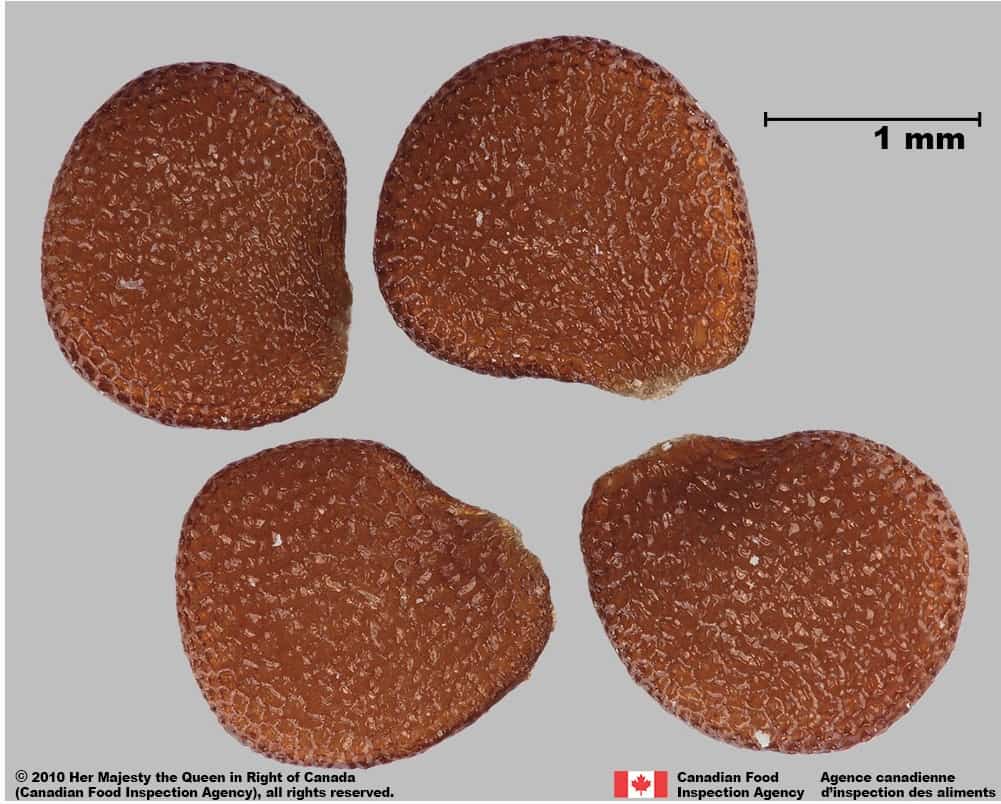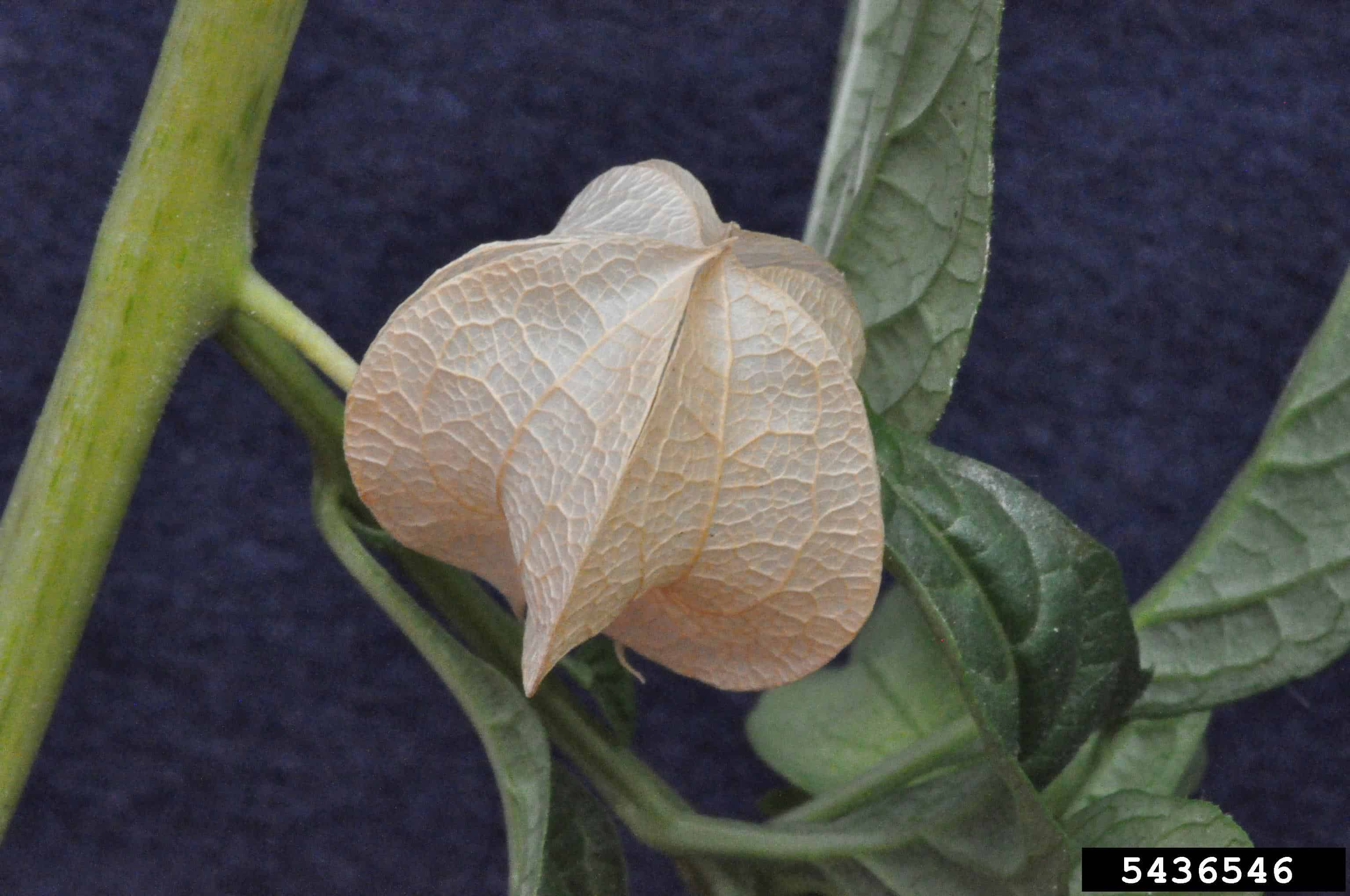Nicandra physalodes
Overview
Aperçu
Regulation :
Remarques Réglementation:
- CFIA Weed Seeds Order - Class 2: Primary Noxious Weed Seeds
- USA Federal Noxious Weed Seed List
Regulation Notes:
Distribution :
Répartition :
Native to South America and widely introduced elsewhere, including North America, Asia, Africa, eastern Europe, Australia and New Zealand (CABI 2022; USDA-ARS 2022). In the United States it occurs mainly in the eastern and Midwestern states (Kartesz 2015). In Canada, it occurs generally in Ontario and Quebec and is rare in British Columbia, Nova Scotia and Prince Edward Island (Brouillet et al. 2010+; Darbyshire 2003).
Habitat and Crop Association :
Habitat et Cultures Associées :
Nicandra physalodes grows in cultivated fields, old fields, gardens, roadsides and disturbed areas (Scoggan 1979; Gleason and Cronquist 1991; Darbyshire 2003). It infests a wide range of crops, including cereals, Glycine max (soybeans), Phaseolus vulgaris (beans), Zea mays (corn), Sorghum bicolor (sorghum), Gossypium hirsutum (cotton) and vegetables, as well as pastures, orchards and vineyards (Holm et al. 1997; CABI 2022).
Economic Use, cultivation area, and Weed Association :
Utilisation économique, zone de culture et association de mauvaises herbes :
Duration of Life Cycle :
Durée du cycle vital:
Annual
Dispersal Unit Type :
Type d’unité de dispersion :
Seed
General Information
RENSEIGNEMENTS GÉNÉRAUX
Nicandra physalodes has been reported to produce an average of 16,000 seeds per plant, and be as high as 40,000 seeds (Holm et al. 1997). Seeds are dispersed by water, soil movement and as a contaminant in grain and birdseed (Holm et al. 1997; CABI 2022). Seeds can remain viable in undisturbed soil up to 15 years (Holm et al. 1997).
.
Nicandra physalodes plant (Ohio State Weed Lab , The Ohio State University, Bugwood.org)
Identification
Identification
-
Berry
Size
- Berry diameter: 10.0 – 15.0 mm (Holm et al. 1997)
Shape
- Berry is globose
Surface Texture
- Berry surface is smooth (Holm et al. 1997)
Colour
- Berry is yellowish (Holm et al. 1997)
Other Features
- The calyx enlarges in maturity to enclose the berry
- The calyx is brown coloured and a papery consistency when mature (Holm et al. 1997)

Nicandra physalodes berry and calyx



-
Seed
Size
- Seed length*: 1.4 2.3 mm; width: 1.3 – 1.8 mm
*Note: minimum and maximum of 20 seeds in a normal range of this species using image measurement (ISMA 2020)
Shape
- Seed is D-shaped or oval, compressed in edge view
Surface Texture
- Seed texture is wavy ridged reticulate with thick ridges and deep, concave interspaces
Colour
- Seed is glossy orange to brownish-orange
Other Features
Hilum and Hilum area
- Hilum is a closed slit along the narrow edge of the seed near one end

Apple of Peru (Nicandra physalodes) seeds




-
Embryo
Size
- Embryo partially fills the seed
Shape
- Embryo is circular
Endosperm
- Endosperm is soft and translucent white
Other Features
- Embryo is in a peripheral position in the seed
Identification Tips
CONSEILS POUR L’IDENTIFICATION
D-shaped seeds that are compressed in edge view is a common seed shape in the Solanaceae. The combination of a glossy orange or brownish-orange colour, thick, wavy ridged reticulation and deep interspaces is characteristic of this species. Other seeds in the Solanaceae generally have thin ridged reticulation, shallow interspaces, and are a shiny yellow colour.

Apple of Peru (Nicandra physalodes) seed







Additional Botany Information
AUTRES RENSEIGNEMENTS BOTANIQUES
Flowers/Inflorescence
- Flowers are bell-shaped and pale blue to white in colour (CABI 2022)
Vegetative Features
- Plants are 1 – 2 meters in height with ribbed stems and alternate leaf arrangement (CABI 2022)

Nicandra physalodes flower (Bruce Ackley, The Ohio State University, Bugwood.org)





Similar Species
ESPÈCES SEMBLABLES
Similar species are based on a study of seed morphology of various species, and those with similar dispersal units are identified. The study is limited by physical specimen and literature availability at the time of examination, and possibly impacted by the subjectivity of the authors based on their knowledge and experience. Providing similar species information for seed identification is to make users aware of similarities that could possibly result in misidentification.
Physalis pubescens L. (husk tomato)
Physalis pubescens seeds (length*: 1.6 – 3.5 mm; width: 1.4 – 2.1 mm) are generally larger than Nicandra physalodes, but the size ranges do overlap. The seeds are glossy yellow or orange with wavy ridged reticulation and longer interspaces near the hilum, compared to orange or brownish-orange seeds and the uniform interspaces of N. physalodes.
* Note: minimum and maximum of 10 seeds in a normal range of this species using image measurement (ISMA 2020)
Click to select species
Cliquez pour sélectionner les espèces

Physalis pubescens
Comparison Window
Fenêtre de comparaison
MAIN SPECIES
ESPÈCES PRINCIPALES
Nicandra physalodes

Nicandra physalodes
Solanaceae
Apple of Peru (Nicandra physalodes) seeds
MAIN SPECIES
ESPÈCES PRINCIPALES
Nicandra physalodes

Nicandra physalodes
Solanaceae
Apple of Peru (Nicandra physalodes) seeds
MAIN SPECIES
ESPÈCES PRINCIPALES
Nicandra physalodes

Nicandra physalodes
Solanaceae
Apple of Peru (Nicandra physalodes) seed
MAIN SPECIES
ESPÈCES PRINCIPALES
Nicandra physalodes

Nicandra physalodes
Solanaceae
Apple of Peru (Nicandra physalodes) seed, side view
MAIN SPECIES
ESPÈCES PRINCIPALES
Nicandra physalodes

Nicandra physalodes
Solanaceae
Nicandra physalodes berry and calyx
MAIN SPECIES
ESPÈCES PRINCIPALES
Nicandra physalodes

Nicandra physalodes
Solanaceae
Nicandra physalodes calyx and berry
MAIN SPECIES
ESPÈCES PRINCIPALES
Nicandra physalodes

Nicandra physalodes
Solanaceae
Nicandra physalodes calyx closeup view
SIMILAR SPECIES
ESPÈCES SEMBLABLES
Physalis pubescens

Physalis pubescens
Solanaceae
Physalis pubescens seeds
SIMILAR SPECIES
ESPÈCES SEMBLABLES
Physalis pubescens

Physalis pubescens
Solanaceae
Physalis pubescens seeds
SIMILAR SPECIES
ESPÈCES SEMBLABLES
Physalis pubescens

Physalis pubescens
Solanaceae
Physalis pubescens seed
Need ID Help?
Besoin d’aide pour l’identification?
Reference(s)
Référence(s)
Brouillet, L., Coursol, F., Meades, S. J., Favreau, M., Anions, M., Bélisle, P. and Desmet, P. 2010+. VASCAN, the database of vascular plants of Canada. http://data.canadensys.net/vascan/ Accessed March 03, 2022.
Centre for Agriculture and Bioscience International (CABI). 2022. Invasive Species Compendium, CAB International, Wallingford, UK. https://www.cabidigitallibrary.org/journal/cabicompendium Accessed March 03, 2022.
Darbyshire, S. J. 2003. Inventory of Canadian Agricultural Weeds. Agriculture and Agri-Food Canada, Research Branch. Ottawa, ON.
Gleason, H. A. and Cronquist, A. 1991. Manual of vascular plants of northeastern United States and adjacent Canada. The New York Botanical Garden, Bronx, New York.
Global Biodiversity Information Facility (GBIF) Secretariat. 2022. https://doi.org/10.15468/39omei Accessed via https://www.gbif.org/species/5341754 Accessed December 29, 2022.
Government of Canada (GC). 2016. Canadian Weed Seeds Order. https://laws-lois.justice.gc.ca/eng/regulations/SOR-2016-93/page-2.html (English) https://laws-lois.justice.gc.ca/fra/reglements/DORS-2016-93/page-2.html (French)
Holm, L., Doll, J., Holm, E., Pancho, J. and Herberger, J. 1997. World Weeds, Natural Histories and Distribution. Jon Wiley & Sons, Inc. 1129 pp.
International Seed Morphology Association (ISMA). 2020. Method for Seed Size Measurement. Version 1.0. ISMA Publication Guide.
Kartesz, J. T. 2015. The Biota of North America Program (BONAP). North American Plant Atlas. Chapel Hill, N.C., www.bonap.org/MapSwitchboard.html Accessed March 03, 2022.
Scoggan, H. J. 1979. Flora of Canada. National Museums of Canada, Ottawa.
U.S. Department of Agriculture-Agricultural Research Services (USDA-ARS). 2022. Germplasm Resources Information Network (GRIN), https://npgsweb.ars-grin.gov/gringlobal/taxon/taxonomysimple.aspx Accessed March 03, 2022.
U.S. Department of Agriculture-Natural Resources Conservation Service (USDA-NRCS). 2022. The PLANTS Database. National Plant Data Team, Greensboro, NC USA. http://plants.usda.gov Accessed December 29, 2022.




